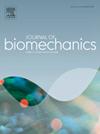Intervertebral disc deformation in the lower lumbar spine during object lifting measured in vivo using indwelling bone pins
IF 2.4
3区 医学
Q3 BIOPHYSICS
引用次数: 0
Abstract
Object lifting is often categorized into squat and stoop techniques, with the former believed to protect the back by maintaining a neutral spine, and the latter considered harmful due to spinal flexion. Despite the widespread promotion of these beliefs, there is no evidence to support such dichotomy, as spinal flexion is not conclusively linked to low back pain. This study aimed to investigate intervertebral disc deformation in the lower lumbar spine during squat and stoop lifting using indwelling bone pins. Five healthy males underwent insertion of Kirschner wires into the L3, L4, and L5 spinous processes, followed by biomechanical data collection using magnetic and optical tracking systems during upright standing, isolated flexion/extension, and object lifting with both squat and stoop techniques. Except for one subject, stoop lifting resulted in up to 90 % greater disc wedging compared to squat lifting, with a significant difference at L4/L5 (p = 0.042). The anterior annulus fibrosus experienced 10 % to 40 % more compression during stoop lifting, but no significant differences were found in posterior annulus fibrosus expansion between techniques. Lever arms were about 35 % longer during stoop compared to squat lifting. These results indicate that even though stoop lifting generally led to greater disc deformation, significant deformation was also observed during squat lifting, challenging the notion of maintaining a neutral spine with this technique. Moreover, the considerable variability observed among participants raises concerns about the suitability of current one-size-fits-all lifting guidelines.
使用留置骨针活体测量下腰椎间盘在提举物体过程中的变形。
物体提举通常分为下蹲和弯腰两种技术,前者被认为可以通过保持脊柱中立来保护背部,而后者则被认为由于脊柱弯曲而有害。尽管这些观点得到了广泛的宣传,但并没有证据支持这种二分法,因为脊柱弯曲与腰痛并没有确凿的联系。本研究旨在利用留置骨针调查下蹲和弯腰举重时下腰脊柱椎间盘的变形情况。五名健康男性分别在 L3、L4 和 L5 棘突中插入了 Kirschner 线,然后使用磁性和光学跟踪系统收集了直立、孤立屈伸以及采用下蹲和弯腰技术抬举物体时的生物力学数据。除一名受试者外,弯腰抬举与下蹲抬举相比,椎间盘楔入程度最多可增加 90%,在 L4/L5 处差异显著(p = 0.042)。在弯举过程中,椎间盘前纤维环受到的挤压增加了10%到40%,但在椎间盘后纤维环膨胀方面,不同技术之间没有发现显著差异。与蹲举相比,弯举时的杠杆臂长约 35%。这些结果表明,尽管弯举通常会导致椎间盘更大的变形,但在蹲举过程中也观察到了明显的变形,这对使用这种技术保持脊柱中立的观点提出了挑战。此外,在参与者之间观察到的巨大差异也让人们对目前 "一刀切 "的举重指南是否适用产生了担忧。
本文章由计算机程序翻译,如有差异,请以英文原文为准。
求助全文
约1分钟内获得全文
求助全文
来源期刊

Journal of biomechanics
生物-工程:生物医学
CiteScore
5.10
自引率
4.20%
发文量
345
审稿时长
1 months
期刊介绍:
The Journal of Biomechanics publishes reports of original and substantial findings using the principles of mechanics to explore biological problems. Analytical, as well as experimental papers may be submitted, and the journal accepts original articles, surveys and perspective articles (usually by Editorial invitation only), book reviews and letters to the Editor. The criteria for acceptance of manuscripts include excellence, novelty, significance, clarity, conciseness and interest to the readership.
Papers published in the journal may cover a wide range of topics in biomechanics, including, but not limited to:
-Fundamental Topics - Biomechanics of the musculoskeletal, cardiovascular, and respiratory systems, mechanics of hard and soft tissues, biofluid mechanics, mechanics of prostheses and implant-tissue interfaces, mechanics of cells.
-Cardiovascular and Respiratory Biomechanics - Mechanics of blood-flow, air-flow, mechanics of the soft tissues, flow-tissue or flow-prosthesis interactions.
-Cell Biomechanics - Biomechanic analyses of cells, membranes and sub-cellular structures; the relationship of the mechanical environment to cell and tissue response.
-Dental Biomechanics - Design and analysis of dental tissues and prostheses, mechanics of chewing.
-Functional Tissue Engineering - The role of biomechanical factors in engineered tissue replacements and regenerative medicine.
-Injury Biomechanics - Mechanics of impact and trauma, dynamics of man-machine interaction.
-Molecular Biomechanics - Mechanical analyses of biomolecules.
-Orthopedic Biomechanics - Mechanics of fracture and fracture fixation, mechanics of implants and implant fixation, mechanics of bones and joints, wear of natural and artificial joints.
-Rehabilitation Biomechanics - Analyses of gait, mechanics of prosthetics and orthotics.
-Sports Biomechanics - Mechanical analyses of sports performance.
 求助内容:
求助内容: 应助结果提醒方式:
应助结果提醒方式:


